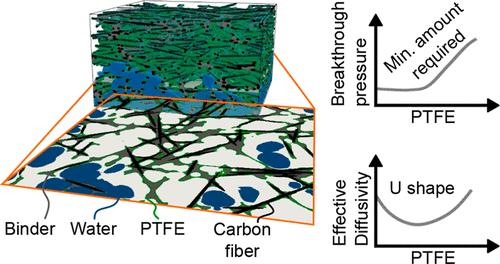当前位置:
X-MOL 学术
›
ACS Appl. Mater. Interfaces
›
论文详情
Our official English website, www.x-mol.net, welcomes your feedback! (Note: you will need to create a separate account there.)
Unveiling the Role of PTFE Surface Coverage on Controlling Gas Diffusion Layer Water Content
ACS Applied Materials & Interfaces ( IF 8.3 ) Pub Date : 2024-06-27 , DOI: 10.1021/acsami.4c04641 Florian Wiesner 1, 2 , James Woodford 2 , Mayank Sabharwal 2 , Matthias Hesselmann 1 , Seongyeop Jung 2 , Matthias Wessling 1, 3 , Marc Secanell 2
ACS Applied Materials & Interfaces ( IF 8.3 ) Pub Date : 2024-06-27 , DOI: 10.1021/acsami.4c04641 Florian Wiesner 1, 2 , James Woodford 2 , Mayank Sabharwal 2 , Matthias Hesselmann 1 , Seongyeop Jung 2 , Matthias Wessling 1, 3 , Marc Secanell 2
Affiliation

|
Gas diffusion layers (GDLs) are usually coated with a hydrophobic agent to achieve a delicate balance between liquid and gas phases to maximize mass transport. Yet, most GDL numerical models to date have assumed an average contact angle for all materials, thereby eliminating the possibility of studying the role of the polytetrafluoroethylene (PTFE) content. This study introduces two mixed wettability algorithms to predict the mixed wetting behavior of GDLs composed of multiple materials. The algorithms employ contact angle and distance to solid materials to determine the critical capillary pressure for each pore voxel. The application of the algorithms to the estimation of capillary pressure vs saturation curves for two GDLs, namely, a micro-computed tomography (μ-CT) reconstructed SGL 39BA GDL and a stochastically reconstructed Toray 120C GDL, showed that, in agreement with experimental data, the addition of PTFE resulted in a decrease in saturation at a given capillary pressure. For Toray-120C, the mixed wettability model was capable of reproducing experimentally observed features in the intrusion curve at low saturation that could not be reproduced with a single wettability model, providing a clear link between PTFE coverage and intrusion at low saturation. Numerical results also predicted an increased breakthrough pressure and a decrease in saturation with increasing PTFE, in agreement with experimental observations. The decreased saturation at breakthrough improves gas transport through the layer while maintaining the layer’s ability to remove water. Diffusivity simulations confirm the increase in diffusivity at breakthrough with increasing PTFE, thereby providing a rationale for the addition of PTFE, as well as for the optimal amount. This study emphasizes the importance of multimaterial wetting models and calls for more detailed investigations into PTFE and ionomer distributions in GDLs and catalyst layers, respectively.
中文翻译:

揭示 PTFE 表面覆盖对控制气体扩散层含水量的作用
气体扩散层 (GDL) 通常涂有疏水剂,以实现液相和气相之间的微妙平衡,从而最大限度地提高质量传输。然而,迄今为止,大多数 GDL 数值模型都假设所有材料的平均接触角,从而消除了研究聚四氟乙烯 (PTFE) 含量作用的可能性。本研究引入了两种混合润湿性算法来预测由多种材料组成的 GDL 的混合润湿行为。该算法利用接触角和与固体材料的距离来确定每个孔隙体素的临界毛细管压力。应用该算法来估计两种 GDL(即微型计算机断层扫描 (μ-CT) 重建的 SGL 39BA GDL 和随机重建的 Toray 120C GDL)的毛细管压力与饱和度曲线,结果表明,与实验数据一致,PTFE 的添加导致给定毛细管压力下的饱和度降低。对于 Toray-120C,混合润湿性模型能够重现低饱和度下侵入曲线中实验观察到的特征,而这些特征无法用单一润湿性模型重现,从而在低饱和度下 PTFE 覆盖率和侵入之间提供了清晰的联系。数值结果还预测,随着 PTFE 的增加,突破压力会增加,饱和度会降低,这与实验观察结果一致。突破时饱和度的降低改善了通过该层的气体传输,同时保持了该层去除水的能力。扩散率模拟证实了随着 PTFE 的增加,突破时的扩散率也随之增加,从而为添加 PTFE 以及最佳用量提供了理论依据。 这项研究强调了多材料润湿模型的重要性,并呼吁分别对 GDL 和催化剂层中的 PTFE 和离聚物分布进行更详细的研究。
更新日期:2024-06-30
中文翻译:

揭示 PTFE 表面覆盖对控制气体扩散层含水量的作用
气体扩散层 (GDL) 通常涂有疏水剂,以实现液相和气相之间的微妙平衡,从而最大限度地提高质量传输。然而,迄今为止,大多数 GDL 数值模型都假设所有材料的平均接触角,从而消除了研究聚四氟乙烯 (PTFE) 含量作用的可能性。本研究引入了两种混合润湿性算法来预测由多种材料组成的 GDL 的混合润湿行为。该算法利用接触角和与固体材料的距离来确定每个孔隙体素的临界毛细管压力。应用该算法来估计两种 GDL(即微型计算机断层扫描 (μ-CT) 重建的 SGL 39BA GDL 和随机重建的 Toray 120C GDL)的毛细管压力与饱和度曲线,结果表明,与实验数据一致,PTFE 的添加导致给定毛细管压力下的饱和度降低。对于 Toray-120C,混合润湿性模型能够重现低饱和度下侵入曲线中实验观察到的特征,而这些特征无法用单一润湿性模型重现,从而在低饱和度下 PTFE 覆盖率和侵入之间提供了清晰的联系。数值结果还预测,随着 PTFE 的增加,突破压力会增加,饱和度会降低,这与实验观察结果一致。突破时饱和度的降低改善了通过该层的气体传输,同时保持了该层去除水的能力。扩散率模拟证实了随着 PTFE 的增加,突破时的扩散率也随之增加,从而为添加 PTFE 以及最佳用量提供了理论依据。 这项研究强调了多材料润湿模型的重要性,并呼吁分别对 GDL 和催化剂层中的 PTFE 和离聚物分布进行更详细的研究。






































 京公网安备 11010802027423号
京公网安备 11010802027423号